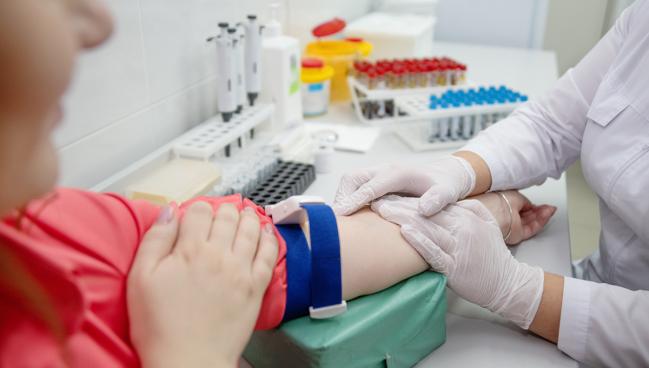Lipid Panels in Standard Precath Blood Draws? Researchers Say It’s Time
“I don’t see how you defend not looking at a patient’s lipids at the time you’re doing an angiogram,” Ajay Kirtane says.

For patients undergoing coronary angiography for the assessment of atherosclerotic heart disease, it should be standard practice to include a lipid panel in precatheterization blood testing if a recent one hasn’t been performed, three physicians argue in a recent JAMA Cardiology viewpoint.
Diagnostic angiography is the ideal time to address optimization of lipid-lowering therapies for these patients, regardless of whether obstructive disease is found, which would ultimately improve patient outcomes, write Lauren Ranard, MD, Eamon Duffy, MD, and Ajay Kirtane, MD (all from Columbia University Irving Medical Center, New York, NY).
“Philosophically, I’ve always been an interventionalist that feels that whatever intervention the patient needs that works is something that we ought to get behind,” said Kirtane, who is also a faculty member of the Cardiovascular Research Foundation, the publisher of TCTMD. He noted that a prior study from his group showed that fewer than half of patients undergoing higher-risk PCI had an LDL cholesterol level at goal at the time of the procedure.
Nevertheless, Kirtane said an informal canvassing of his colleagues suggests that many—or perhaps, most—cath labs aren’t making a point of scrutinizing a patient’s lipids around the time of the procedure. Instead, typical testing focuses on other issues like the metabolic profile and complete blood cell count that have a more-direct bearing on the risk of the intervention.
“To me, it seems like a pretty easy thing to do—patients are getting blood draws anyway,” Kirtane said about adding a lipid panel to precath testing. And after patients find out they have atherosclerotic plaque, whether it’s on an angiogram or some other imaging test, he added, “that’s exactly the time when it’s best to teach them and sort of implement a plan so as to reduce the plaque from progressing.”
As a noninvasive cardiologist, Christopher Cannon, MD (Brigham and Women’s Hospital, Boston, MA), told TCTMD that the idea proposed in this viewpoint is “brilliantly simple.”
When a patient is in the cath lab, “it is a perfect time to make an adjustment to cholesterol management, and having the value sitting in front of you as you’re dictating your discharge note from the cath lab becomes an easy way to facilitate that intensification of lipid management. So I really like the idea.”
Statin Prescription Might Not be Enough
Kirtane said some of his interventional colleagues told him that they make sure their patients are on high-dose statins before leaving the cath lab. But even this might not be enough to ensure that lipid-lowering therapies are optimized, he said, noting that some patients won’t tolerate high-dose statins and others will need adjunctive therapies like ezetimibe or PCSK9 inhibitors to get sufficient reductions in cholesterol.
It would be relatively simple to add a lipid panel to precath blood testing, Kirtane said, since it could be added to the order set. This has been done at Columbia, he noted.
Then it’s just a matter of adopting the mentality that it’s critical to address lipid management when a patient is in the cath lab. Kirtane said that when he has a patient undergoing diagnostic angiography, he calls the referring physician to discuss a plan for lipid-lowering therapy.
“I think if folks don’t do that, that’s actually a very big missed opportunity for care, because the reason the patient’s coming into the cath lab is not for a stent,” he said. “They’re coming into the cath lab to get a diagnosis and for everything that goes along with treating that diagnosis. The stent may be part of that, but the lipid-lowering therapy is clearly essential.”
Asked whether there might be some pushback from interventional cardiologists who might feel that lipid management is under the purview of either primary care physicians or noninvasive cardiologists, Kirtane said, “I don’t see how you defend not looking at a patient’s lipids at the time you’re doing an angiogram to diagnose plaque. It’s as fundamental as saying hi to the patient before you do a procedure on them. That should be standard of care because we know that managing the lipids is one of the few modifiable ways that we can alter the patient’s prognosis. And so why wouldn’t we do that? That’s just good clinical care and being a good doctor.”
Cannon said he wouldn’t expect the addition of the lipid panel, and greater consideration of the results when managing patients, to be much of a burden because controlling cholesterol is such a positive, evidence-based intervention.
“I would think the interventionalist would like it. It will probably help their longer-term outcomes,” Cannon said, noting that there’s evidence from trials like PROVE-IT that the benefits of intensification of lipid-lowering therapy can start to emerge very early on.
Adding a standard lipid panel in the cath lab is “so straightforward that it makes very good sense to do,” he said.
Todd Neale is the Associate News Editor for TCTMD and a Senior Medical Journalist. He got his start in journalism at …
Read Full BioSources
Ranard LS, Duffy EY, Kirtane AJ. The case for inclusion of a lipid panel in the standard precatheterization laboratory blood draw—stating what should be obvious. JAMA Cardiol. 2023;Epub ahead of print.
Disclosures
- Ranard reports receiving grants from Boston Scientific and personal fees from 4C Medical and Philips outside the submitted work.
- Kirtane reports receiving grants from Amgen and consulting or speaker fees from Medtronic, Boston Scientific, Abbott Vascular, Amgen, CSI, Philips, ReCor Medical, Neurotronic, Biotronik, Chiesi, Bolt Medical, Magenta Medical, Canon, SoniVie, Shockwave Medical, Merck, IDMS, Medtronic, CathWorks, Edwards, Novartis, Abiomed, Zoll, and Regeneron relevant to the submitted work.
- Duffy reports no relevant conflicts of interest.





Comments